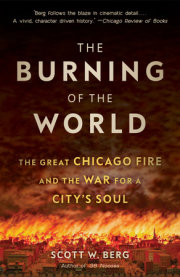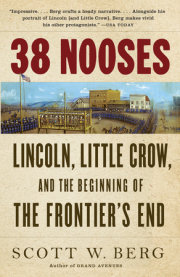PART 1 FIRE Far below the walkway that circled the top of the Cook County courthouse, Chicago spread itself out beneath Mathias Schaefer, an ordinary fireman in the most fire-prone city in the world. Overhead, the sky was clear, the moon three-quarters full. The sun had set more than an hour earlier.
A hundred and twenty feet below his perch, Schaefer could see pinpricks of gaslight illumination, hear the occasional voices of men and women going home from the taverns, theaters, and churches that ringed the courthouse square, or watch the occasional shopkeeper lock up for the night. Sunday night was a quiet time downtown, a lull before the noisy, surging storm of workers who would overwhelm the central business district at the start of the new workweek. A warm October wind rushed across the city from the southwest, a wind that carried a tinge of the odor of the Union Stock Yards and of hundreds of small West Side factories before it piled the waves along the Illinois Central breakwater at the edge of Lake Michigan.
Schaefer was not a watchman by occupation, and this post was a temporary assignment. His usual place was not up here but out there, “on the nozzle,” as they said. Pipemen were their own breed. First in, first to feel the heat and breathe the smoke, too often the first to die. Like so much of the paid labor in Chicago—jobs defined by pulling, lifting, pushing, shoving, sawing, stacking, hauling, throwing, breaking, and battering—fighting fires wore you down. Still, to be a fireman was a big step up from most menial work. It was a job a man could brag about, one he used familial or ethnic or political connections to arrange. It paid him $75 a month or more and earned him the respect of the men at the station, the gratitude of the public, and the admiration of the girls and their mothers.
Walking the tight circle with Schaefer were two young women, sisters of other firemen. They’d brought him supper from the Blenis House hotel down the street and across the river, a small fee to pay for the magnificent view they now enjoyed. Schaefer lived in a boardinghouse on the South Side, beyond the business district, where he roomed with a policeman, a laborer, and a sign painter. But his true home was his station, where he often slept and more often ate—unless he was posted here.
In this era of breakneck technological progress just before the invention of the skyscraper—an invention that would make its first appearance four blocks south of where Schaefer now stood—the courthouse was an anachronism: an archaic, quasi-medieval lump of dirty gray stone that served as a bureaucratic battlement, a vast information warehouse, and, above all, a testament to Chicago’s rising commercial supremacy over the middle and western portions of the United States. The courthouse was an ugly building, but a broad-shouldered kind of ugly that Chicagoans could appreciate. In the five stories beneath Mathias Schaefer’s feet, one and a half of which lay underground, the political and administrative engines of Chicago churned. Here were located the central offices of the police and fire departments, the mayor’s office, the chambers of the Common Council and the Board of Public Works, the city’s courts, its law library, its jail, and, not least, every scrap of paper bearing every real estate and tax record for the city of Chicago.
The only piece of the building that might be described as elegant was its cupola, a cylindrical two-story tower ringed with rounded windows and a balustraded balcony, above which was housed the courthouse’s giant bell. Beneath the bell, down a broad stairway and occupying the lower half of the cupola, sat the circular telegraph room, where signals were collected from 172 numbered fire alarm boxes scattered around the city. Attached to drugstores, saloons, and other establishments, or placed inside fire stations, each of these boxes operated with the turn of a key and a single pull of an iron lever. The newfangled electrical model—the old ones used an unreliable hand crank—had been installed that summer, the keys entrusted to well-known men in their neighborhoods.
The telegraph room of the courthouse held twenty-five relays that could send a signal out from the building and sound a series of tones in any or all of the city’s twenty-five fire stations. All these lines, incoming and outgoing, a system of wires snaking through the city on white-pine posts, converged just below Mathias Schaefer. There, in the middle of the telegraph room, sat William Brown, the spider waiting at the center of this quivering electronic web. Brown entertained his own guest, and from below Schaefer came the soft strum of a guitar.
The two men operated in tandem. William Brown’s job was to send and receive the alarm signals and to set the bell to tolling. Schaefer’s task was to circle the cupola and watch over the city, to decide what was a fire and what wasn’t and then to decide where the fire was. Discernment was everything. Care was needed not to mistake the orange glow of a gasworks or the smoke from a small factory for a genuine event. To call down a false alarm was embarrassing and unprofessional. But more to the point, it was dangerous.
The job was difficult enough in the day, but at night the city seen from up high, especially on a Sunday, was a sea of darkness littered with an intermittent confusion of gaslights, lanterns, and candlelit windowpanes. To round out the fire department’s night watch, additional observers stood in enclosures atop each of the city’s sixteen steam-engine stations during the hours after dark. But all these other sentries were as thrushes to Schaefer’s hawk. His was the only viewpoint that encompassed the entire city.
Many others had walked this cupola balcony before Schaefer, but none would afterward. If this Sunday evening in October 1871 was the last moment in the life of old Chicago—its last breath, as it were—then Mathias Schaefer might be considered the last person to see old Chicago alive.
Copyright © 2023 by Scott W. Berg. All rights reserved. No part of this excerpt may be reproduced or reprinted without permission in writing from the publisher.















